My first visit to Barcelona had been much too short. With only a few days remaining before I was due in Paris, I hopped aboard a double-decker bus for an orientation tour, hoping it would help me choose from among the many interesting sites around the city. From my upper-level seat on the open-airbus I looked down into the labyrinthine streets of the Gothic Quarter, making a mental note to explore this area on foot, but it was not to be on that visit. There was so much to see and do in Barcelona that I didn’t even have time to walk the entire length of La Rambla, the famous pedestrian street that connects Plaça Catalunya with the seafront.
After six weeks of wandering around France I returned to Barcelona, anxious to see more. Early the first morning I stuffed my pockets with snacks purchased at the Boqueria Market and headed into the Gothic Quarter. Within minutes I was deliciously lost in a maze of cobblestone streets where sinister gargoyles peered down from rooftop perches and narrow lanes emerged into broad plazas. Though awed by the beautiful architecture, I was also frustrated; I had absolutely no idea what I was looking at. I decided to call in an expert.
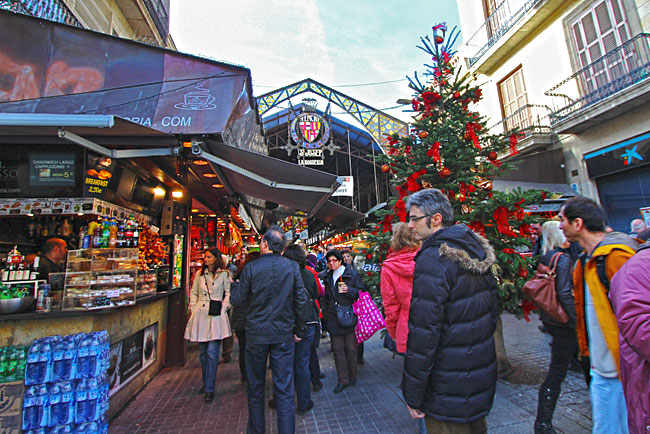
The following morning I met Nancy Daum Daily for a half-day “Undiscovered Corners of the Barrio Gotico Tour” with GetYourGuide. Nancy knew all the hidden courtyards and secret gardens within the quarter and was intimately familiar with its history and architecture. Surprisingly, much of what we think of as Gothic architecture in the quarter was anything but. The Gothic Quarter (Barrio Gótico in Spanish, or Barri Gòtic in Catalan) was originally settled in the 3rd or 2nd century B.C., though other than surviving coinage from that era, we know little about its first inhabitants.
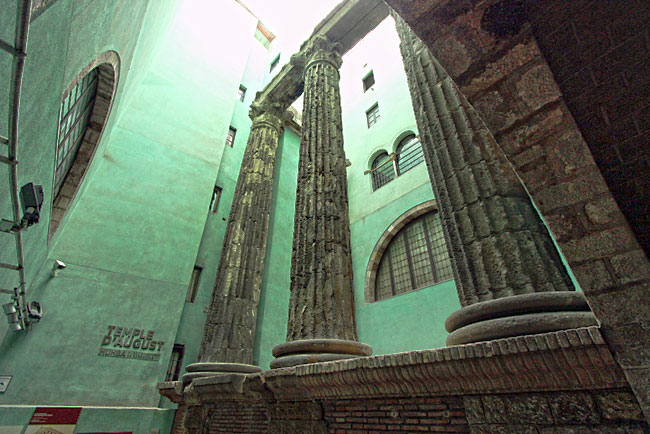
Recoded history begins in 19 B.C., when the entire Iberian Peninsula was conquered by the Roman Empire. Barcino, as the early city was known, thrived under Roman control. During this time the Temple of Augustus, a structure dedicated to religious purposes, was built in the center of the main square known as the forum. Considered one of the most important buildings in the city, the temple was elevated on a ten-foot high podium and surrounded by 30-foor high columns with fluted shafts and Corinthian capitals. Remarkably, four of these 2,000-year old columns have survived, along with the architrave that joined them and a portion of the podium. A medieval structure was later built around the columns, incorporating them into its design. The building was purchased in the early 20th century by the Hiking Club of Catalonia, which hired an architect to create an inner courtyard, where today the majestic columns stand for all to see.
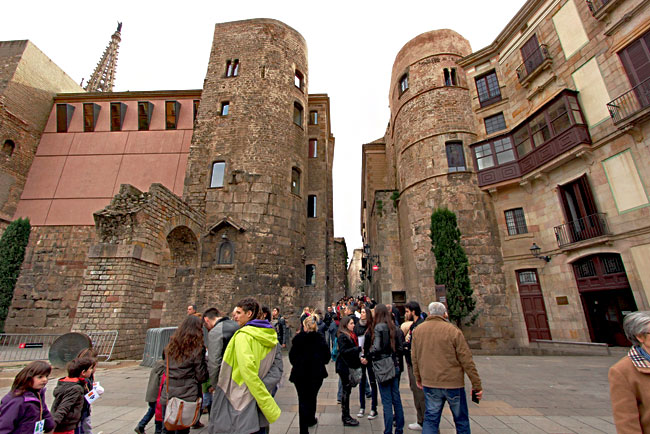
Beginning in 250 AD, raids by Germanic tribes necessitated that the city be fortified. A double stone wall, up to 25-feet high in places and punctuated by 78 watchtowers measuring up to 59-feet tall, was constructed around the entire city. The area enclosed by those original walls comprises the present day Gothic Quarter. Nancy pointed out several places where the original wall had been incorporated into modern buildings, but then led me to Plaza Nova where a Roman water aqueduct has been reproduced and attached to the largest remaining portion of the original wall and two of the original watchtowers. Turning 180 degrees, she pointed to the facade of the Association of Catalan Architects, which displays an original Picasso graffito.

“The art on this facade is not done in his normal style,” she said. “Picasso had been hired by the association to design the facade but he was taking too long to finish the work. As a result, some of the architects discussed hiring Joan Miró, a contemporary and competitor of Picasso, to compete the work. When Picasso got wind of this he quickly completed his design, which he drew in classic Miró style. He presented it to the association, saying, ‘I heard you wanted a Miró.'” This plaza, more than any other, came to represent Barcelona for me. On one side, a two-millennium old Roman fortification; on the other, a contemporary mural by one of the world’s greatest artists. I saw this juxtaposition everywhere.
Can’t view the above slide show about the Gothic Quarter in Barcelona, Spain? Click here.
In 1835, by which time Barcelona had come under the rule of the Spanish Monarchy, Barcelona’s minister of economy convinced the king that the country needed a strong middle class. With the king’s blessing, he seized ancient churches, monasteries and convents and converted them to hospitals and orphanages, while the land holdings were distributed among the middle class. Today many of these same buildings serve as public offices or agencies, including one that is a Filipino soup kitchen. In 1984, the remains of an ancient synagogue were discovered in a building long used as a hardware warehouse. It was purchased, renovated and re-opened as an active synagogue in 1997. Roman ruins discovered while excavating beneath the floor of the synagogue are displayed through a plate glass floor, upon which weekly Shabbat services are held. The Caelum, believed to have once housed a Jewish ritual bath (mikveh) in its basement, today is a bakery that sells specialty pastries made by nuns from all across Spain.
Even Barcelona’s Cathedral of the Holy Cross and Saint Eulalia, heartbeat of the Gothic Quarter, had been pieced together like a mosaic. Nancy began at the rear, pointing to a small brick chapel that had been roughly stitched to the Gothic cloister on its left.
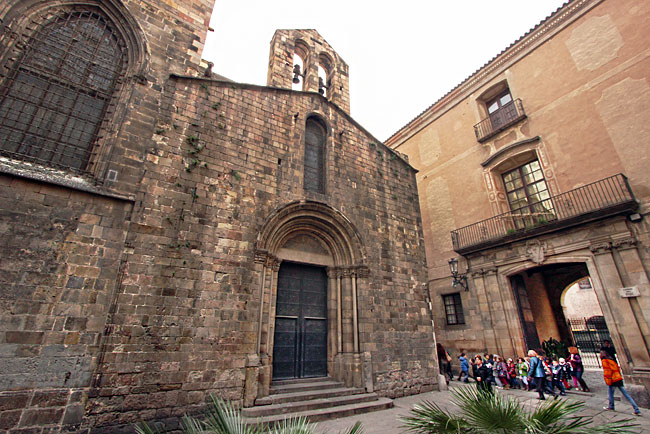
“This is the Chapel of Santa Llúcia, the only remaining piece of the original cathedral, built in Romanesque architectural style in the 13th century,” she said. Leading me around to the front, she pointed to the facade. “The cathedral was quite plain when it was completed in the 15th century. It wasn’t until the 19th century that the exterior was embellished with neo-Gothic designs. Even the two spires on the left and right are not connected to the lower church; they were added for decorative purposes only.”
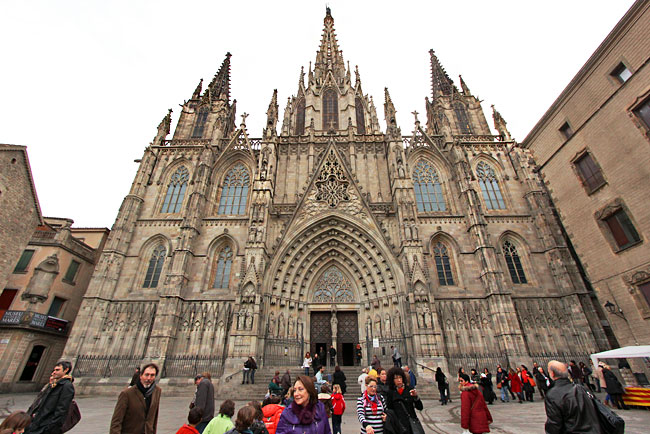
By the end of the morning, my head was spinning with facts and figures and new architectural knowledge, so we decided to grab some lunch. Nancy led me to a tiny cafe that offered delicious vegetarian food. We chatted well beyond the allotted time of her tour and she patiently reviewed all my photos to ensure I had taken accurate notes. I left feeling as if I’d had a crash course on Barcelona’s Gothic Quarter and significant insight into the culture of the city.
The following Sunday morning, my suspicion was confirmed when I had Xurros and Xocolate (Churros and Chocolate) with my friend Isabel Romano, who publishes the Spanish travel blog, Diario de Abordo, and her boyfriend Xavi. They were treating me to yet another walking tour of the Gothic Quarter, Raval District, La Rambla, and the marina when we passed Caelum. Xavi mentioned that it was a very good bakery and I piped up.
“Did you know there’s an old Jewish bath in the basement that is open to the public for tours every afternoon?”
Xavi and Isabel looked at one another and grinned; suddenly I was educating these two long-time residents of Barcelona about their own city. That was the moment I knew just how good Undiscovered Corners of the Barrio Gotico Tour by GetYourGuide had been.
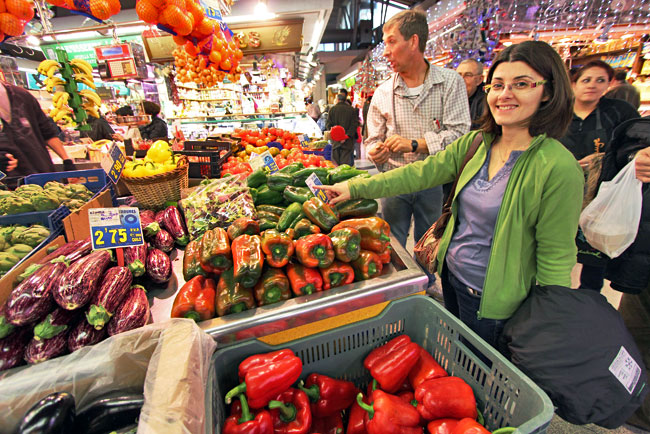
Disclosure: My tours of Barcelona’s Gothic Quarter was provided by GetYourGuide, a booking website for tours and activities in cities across the globe. However, the receipt and acceptance of complimentary items or services will never influence the content, topics, or posts in this blog. I write the truth, the whole truth, and nothing but the truth.

Barcelona, love the city . A city of joy and fun . Spent a great time with my friends in summer. Your blog is too good to get back to those memories i had here
Thanks Daniel! Glad I could bring back good memories.
Love how you include such a detailed history in your posts. You definitely make the point about walking while in a new place, couldn’t agree more.
Thanks so much Tyler. I try hard to research and include the background history of a place, along with my personal experience. Glad you enjoyed the story.
Nice post Gran cantidad de información acerca de los viajes después de leer esto. Me encontré con algo diferente en este post sobre blogs.
Amazing place Barcelona!!! Great photo from the Boqueria marquet… wonderful place… I tryed tha Pata negra ham and I became an adicted!!!!
The cathedral has a small chapel on one site which is really beatiful! Thanks for your post, it made me remenber….
Hi Barbara,i had been to Barcelona and it’s a great fun walking here in street. Ramblas – the main tourist – a pedestrian street in Barcelona is place to walk about here.
Hi John: I agree! Strolling La Rambla is a great way to spend a morning or afternoon – or both 🙂
Very interesting post! I get lots of information about travel after reading this! I really found something different in this post regarding blogs. Hope to see you coming out with more new and informative posts to the soonest possible. Double thumbs up!!
Yes to walking tours of Barcelona! Better yet in a small group. So much to learn and see. I live in Barcelona and did a tour of my own neighborhood a couple years ago and was blown away by all the bits of history I had missed, and had walked past every day!
Hi Reg: Isn’t it interesting that we so often know so little about what’s right in our own backyard?
I traveled to Barcelona last summer. Wondeful city. Mix of old and modern. Highly recommended for anybody looking for torurism.
It’s actually a great and useful piece of information. I’m happy that you simply shared this helpful info with us. Please stay us informed like this. Thanks for sharing.
While I loved gothic Barcelona-Actually, I loved everything about it, except the dive we stayed. It was the modernista’s and Gaudi that captured by heart. This is the brief video I did of Casa Batllo
http://www.rlmnow.com/retirement-travel-discovery-modernista-architects-barcelona/
I was just in Barcelona this past weekend, and hadn’t had a chance to read this before going. Wish I had, what a wealth of info. I’ll bookmark it, though, and return this summer. Thanks!
Thanks Corinne. I know I’ll also be back – love Barcelona.
Barcelona seems to have such a great spirit and energy to it – culture, varied history, great walking. Lovely to see you discovered so much in your short time.
Thanks Mark – it’s officially one of my favorite cities.
Nice post. Glad you got to go back and see this amazing city!
Thanks Ray – yes, my first visit was way to brief. And even after the second time around, I feel there’s so much more to see.
It certainly makes you realise that it is well worth investing in a guide if you want to find about a place and only have a limited amount of time, and especially to find all those hidden gems.
Hi Heather – it probably would have taken me weeks on my own to discover everything that I learned on this walking tour!